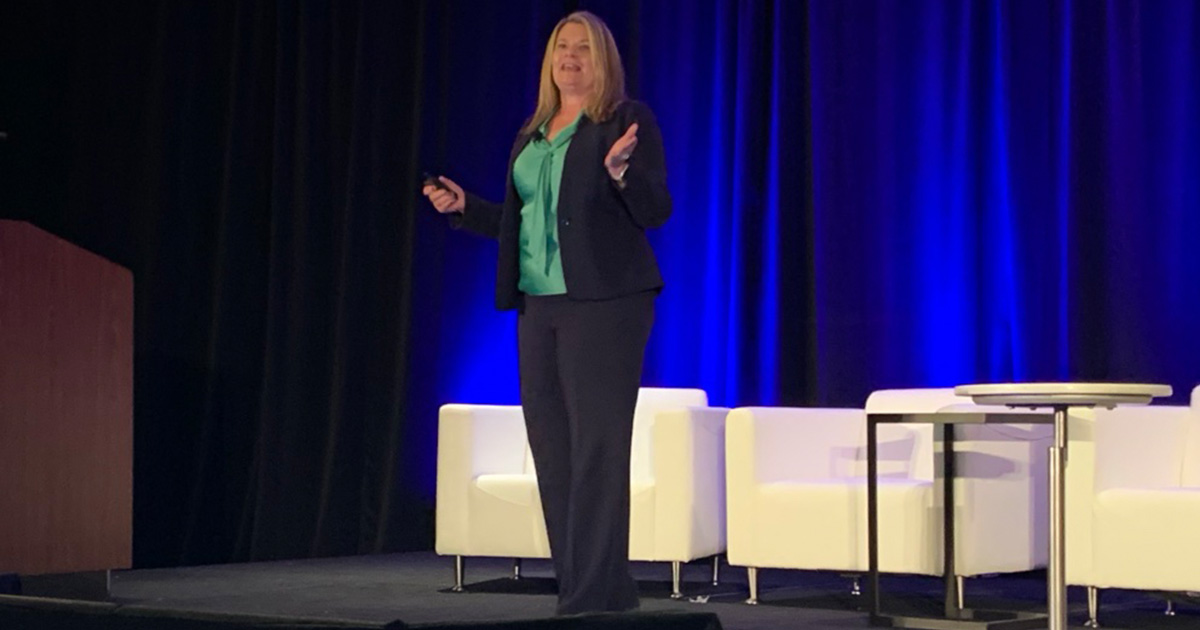
BOSTON – After putting artificial intelligence into systems where nurses are used to working, Mercy has been able to realize $52 million in retaining talent and engaging its workforce, a 20% improvement in nurses’ electronic health records experiences and a 17% increase in nurse efficiency, the health system’s Senior Vice President Betty Jo Rocchio said Thursday at the HIMSS AI in Healthcare Forum.
Healthcare has a “tremendous responsibility as well as opportunity for human flourishing,” Rocchio, the chief nurse executive and a practicing nurse, said.
By transitioning to mobile-based charting, developing an automated nurse credentialing system and working out the kinks using AI to improve emergency department to inpatient handoff across the health system’s 51 hospitals, Mercy has been able to create a more resilient staff and increase retention.
The rewards of the efforts can be found in the numbers.
“We have to have the analytics in the background to say we’re making the right move.”
Why a technology-enabled workforce
Hal Wolf, president and CEO of HIMSS, the parent company of Healthcare IT News, kicked off the forum by discussing the anomalies that healthcare continues to face.
The skilled worker challenge will keep coming back regularly – “one that has every healthcare system looking up and thinking how am I going to use new tools to improve or stretch out my capability to take care of people,” he said.
Back in 2018, healthcare was expecting a gap of 13 million clinicians globally by 2035, which the World Health Organization modified to 18 million about a year ago, he noted.
Rocchio agreed. “I just don’t think we can wait another 10 to 15 years to figure out if we’re going to have the people that we need in the model of care that we deliver today,” she said.
“One of the big focuses is how do we build up the workforce.”
To tackle that, Mercy has focused on leveraging AI to address workflows and work environment challenges.
“If we could straighten out those three things in healthcare – regardless of the site of care, whether it’s hospital at home, whether it’s virtual care or whether it’s at the bedside in an inpatient setting – we would be further ahead today,” she said.
Rocchio said that in looking at evidence-based data, the team of technologists, nursing leaders and informaticists said what is most important across generations working in nursing today is flexible compensation, work-life balance and control over schedule.
“We cannot underestimate today the value of that human flourishing concept and saying while we need people to work a certain way, these newer generations just aren’t going to do it,” she said.
“I’m just going to state it like it is, we’re a mess in healthcare, sometimes in process. We have to go back and clean it up into an organized fashion the way that the technology needs to be consumed.”
The health system’s digital transformation journey followed a path based on Everett Roger’s diffusion of innovation theory and now there’s a system and a process around the workforce layer.
By adding an automated nurse credentialing system, Mercy has decreased the time spent on staffing and scheduling by about 25%, she said.
When core, agency and flex nursing staff are onboarded, they use the credentialing system to architect the shifts they want, and it’s been working.
“The supply-demand concept that’s been around for a million years,” she said. “We applied it in healthcare, put the technology to it and we have the analytics to measure ourselves.”
While the nurse managers were initially concerned about filling their schedules, the data has shown that the staff will pick up the open shifts.
“Two years into this, it’s still working great, and you can still see all the data, and everybody’s calm down. But to get to that point, a little bit of pain.”
Decreasing nurses’ cognitive load
Spending 240 minutes per shift in the EHR will add mental load and lead to more rapid rates of nurse burnout, Rocchio said.
“The whole goal between attacking work environment and workflows is to decrease that cognitive workload on the nurse,” she said.
“We know that keeping them by the patient’s bedside is important. But if we’re increasing their workload while we’re doing it, we’re probably driving them away.”
To address that head-on, Mercy is driving mobile-first operations with Epic’s Rover to minimize their time at the desktop but is also leveraging augmented intelligence to improve patient handoffs from emergency departments.
By cutting across the various lanes used in its EHR – the physicians, medications, labs, pharmacy and more – an AI-enhanced system scrapes across the entire emergency room record to surface the critical information and put it literally in nurses’ hands.
“That recommendation section looks at the orders, looks at what the doctor has signed off on, and puts anything that they’re still left to do for that inpatient nurse, and delivers it to their mobile phone.”
Andrea Fox is senior editor of Healthcare IT News.
Email: afox@himss.org
Healthcare IT News is a HIMSS Media publication.
